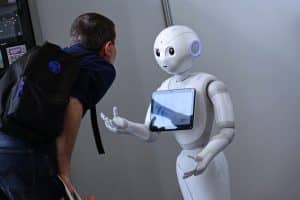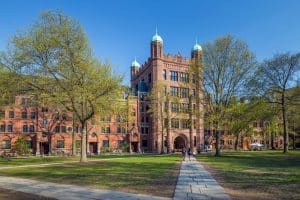The FIRST Robotics Competition: Shaping the Future of STEM
The world of robotics has seen rapid advancements in recent years, and the FIRST Robotics Competition (FRC) is a shining example of what’s possible when young minds are given the opportunity to innovate and create.
The FRC is an international high school robotics competition that combines the excitement of sports with the rigors of science, technology, engineering, and mathematics (STEM). Founded in 1989 by inventor and entrepreneur Dean Kamen, the program aims to inspire young people to pursue STEM careers by engaging them in a challenging and rewarding robotics competition.
The Objectives of the FIRST Robotics Competition
The objectives of the FIRST Robotics Competition extend beyond the realm of robotics, as the competition seeks to inspire a passion for STEM, foster collaboration and teamwork, provide valuable mentorship and networking opportunities, and promote STEM education and community outreach.
By achieving these objectives, the FRC has played a pivotal role in shaping the future of STEM, empowering young minds to become the leaders and innovators of tomorrow.
Objective 1: Encouraging Hands-On Learning and Skill Development
One of the primary objectives of the FRC is to provide students with a platform for hands-on learning where they can apply theoretical concepts to real-world problems. The competition engages high school students in designing, building, and programming robots to perform specific tasks, allowing them to develop a diverse set of skills, including critical thinking, problem-solving, programming, and engineering.
By offering a practical approach to learning, the FRC nurtures students’ creativity and piques their interest in STEM-related subjects, paving the way for future careers in these fields.
Objective 2: Fostering Collaboration and Teamwork
Another key objective of the FIRST Robotics Competition is to promote a collaborative environment that encourages teamwork and cooperation. The competition emphasizes the importance of working together, as students must collaborate with their teammates, mentors, and even other teams to succeed.
This unique approach, known as “Coopertition,” teaches students the value of sharing knowledge, resources, and ideas to achieve a common goal. By fostering a sense of unity and camaraderie, the FRC helps students develop essential communication and leadership skills that are invaluable in both their academic and professional lives.
Objective 3: Providing Mentorship and Networking Opportunities
The FRC offers students the opportunity to connect with industry professionals, educators, and alumni who serve as mentors. These mentors play a crucial role in guiding students through the competition, offering valuable insights and support.
This mentorship allows students to learn from the experiences of professionals in their desired fields and gain practical knowledge that can be applied beyond the competition. Additionally, the FRC serves as a networking platform for participants, enabling them to build lasting connections with their peers and professionals, further contributing to their personal and professional growth.
Objective 4: Promoting STEM Education and Community Outreach
The FRC seeks to inspire a passion for STEM education and raise awareness about the importance of these fields in today’s increasingly technology-driven world. Teams often engage in community outreach efforts, showcasing their robots and sharing their experiences with the public.
These initiatives not only help to demystify STEM subjects but also foster inclusivity and promote access to STEM education for all. By encouraging students to become ambassadors for STEM, the FRC contributes to the development of a more knowledgeable and diverse future workforce.
The History of the Competition
The history of the FIRST Robotics Competition is a testament to the power of innovation, collaboration, and determination in shaping the future of STEM. Founded by inventor Dean Kamen in 1989, the FRC has grown into a global phenomenon that unites students, mentors, and volunteers in the spirit of gracious professionalism, cooperation, and friendly competition.
The Beginnings: A Vision for the Future
The idea for the FIRST Robotics Competition was born out of Dean Kamen’s concern for the lack of interest and representation in STEM fields among young students. Kamen, who is best known for his invention of the Segway, believed that engaging students in a competitive, hands-on learning environment could inspire a passion for STEM and prepare them for future careers in these fields.
In 1989, Kamen teamed up with physicist Woodie Flowers and a group of dedicated volunteers to bring his vision to life. The first FRC, held in a high school gymnasium in New Hampshire, featured 28 teams competing in a simple robotics challenge. Despite the modest beginnings, the event marked the start of a remarkable journey that would ultimately transform the lives of countless students and mentors.
Growth and Expansion: Reaching New Heights
Over the years, FRC gained momentum as more teams joined the event and new regional competitions were established. The competition’s growth was fueled by the increasing interest in robotics and the recognition of the importance of STEM education in the 21st century.
In 1992, the FRC introduced the FIRST Championship, an annual event that brings together teams from regional competitions to compete on a global stage. The Championship has since become a highly anticipated event, attracting thousands of participants, spectators, and sponsors from around the world.
Throughout the 1990s and early 2000s, the FRC continued to expand, establishing new competitions in countries such as Canada, Israel, and Mexico. Today, the FRC boasts over 3,700 teams from more than 30 countries, reflecting its impact as a truly global phenomenon.
Innovation and Progress: A Constantly Evolving Challenge
As the FIRST Robotics Competition expanded, so too did the complexity and sophistication of the competition itself. Each year, a new challenge is introduced, pushing teams to design, build, and program robots that can perform increasingly intricate tasks. These challenges not only test the students’ technical abilities but also require them to develop innovative solutions to real-world problems.
In recent years, the FRC has introduced themes that emphasize contemporary issues such as sustainability, renewable energy, and environmental conservation. These themes not only engage students in current global challenges but also inspire them to think critically about the role of technology and innovation in addressing these issues.
Impact and Legacy: Shaping the Future of STEM
Over the past three decades, the FIRST Robotics Competition has had a significant impact on the lives of its participants and the broader STEM community. The FRC has inspired countless students to pursue careers in STEM fields and equipped them with the skills and experiences necessary to excel in their chosen professions.
Moreover, the FRC’s emphasis on collaboration, mentorship, and community outreach has fostered a strong sense of camaraderie among its members, establishing a global network of passionate and talented individuals who share a common goal: to inspire the next generation of STEM leaders.
Who can participate?
So who can participate? Well, the FRC primarily targets high school students, typically aged between 14 and 18, with an interest in robotics and STEM-related subjects. However, the competition is open to all students within this age range, regardless of their prior experience or skill level. The FRC aims to provide a platform for students from diverse backgrounds to come together, learn from one another, and develop a passion for STEM.
Beyond students, the FRC also encourages participation from industry professionals, educators, and alumni who can serve as mentors and volunteers. These individuals play a crucial role in guiding students through the competition, providing valuable insights, and fostering a collaborative learning environment.
How to join
Let’s talk about how you can join this competition. Here are the steps you can follow:
- Form a Team: The first step to participating in the FIRST Robotics Competition is to form a team. Teams can be established within a school, community organization, or even among a group of like-minded individuals. The ideal team size varies but usually ranges between 15 and 50 members to ensure that tasks can be distributed effectively and all participants have an opportunity to contribute.
- Find a Mentor: A mentor is an invaluable resource for any FRC team, providing guidance, expertise, and support throughout the competition. Mentors can be teachers, industry professionals, or FRC alumni who are willing to dedicate their time and share their knowledge with the team. Recruiting a mentor not only enhances the team’s technical capabilities but also helps develop essential life skills such as communication, teamwork, and problem-solving.
- Register Your Team: Once a team is formed and a mentor is secured, the next step is to register for the FRC. Registration typically opens in the fall and involves creating a team profile on the FIRST website, paying the registration fee, and selecting a regional competition to attend. It is important to register early to secure a spot in the competition and gain access to the season’s resources and updates.
- Secure Funding and Sponsorship: Participating in the FIRST Robotics Competition can be expensive, with costs related to robot parts, competition registration, and travel. To cover these expenses, teams are encouraged to seek funding and sponsorship from local businesses, organizations, and individual donors. Fundraising efforts not only help cover costs but also provide valuable opportunities for students to hone their communication and presentation skills.
- Prepare for the Challenge: Once registered, teams should begin preparations for the upcoming season’s challenge. This includes learning about the specific tasks and requirements, brainstorming strategies, and designing, building, and programming the robot. Throughout this process, students will develop technical skills, problem-solving abilities, and teamwork, preparing them for success in the competition and beyond.
- Participate in Regional Competitions: Teams will compete in regional events, where they will put their robots to the test against other teams from around the world. The top-performing teams will advance to the FIRST Championship, where they will have the opportunity to showcase their skills on a global stage.
The Competition Details
In this part of the blog, we will delve into the competition details of the FRC, exploring its structure, challenges, and opportunities it presents to students and mentors alike.
The Structure: Regional Competitions and the FIRST Championship
The FIRST Robotics Competition is organized into regional competitions, which serve as qualifiers for the FIRST Championship. These regional events take place across the globe, attracting thousands of teams that compete for a chance to showcase their skills on a global stage.
In addition to the regional events, FRC also offers district competitions in certain areas, which provide additional opportunities for teams to qualify for the FIRST Championship.
The FIRST Championship is the culmination of the FRC season, bringing together the best teams from around the world. Held annually in two locations in the United States, the Championship is a multi-day event that celebrates the achievements of participating teams and provides a platform for students to connect with their peers, mentors, and industry professionals.
The Challenges: Creativity, Innovation, and Problem-Solving
Each FRC season introduces a new challenge that requires teams to design robots capable of performing specific tasks. These challenges are often based on contemporary issues, such as environmental conservation, renewable energy, or global health, encouraging students to think critically about the role of technology in addressing real-world problems.
The challenges are designed to test students’ technical skills and creativity while promoting collaboration and problem-solving. Teams must work together to brainstorm strategies, design and build their robots, and program them to complete the required tasks autonomously or via remote control. Throughout this process, students learn to apply theoretical concepts to practical situations, preparing them for careers in STEM fields.
Scoring and Awards: Recognizing Excellence
The FIRST Robotics Competition scoring system varies from year to year, depending on the specific tasks and objectives of the challenge. In general, teams earn points based on their robots’ performance during the matches, such as completing tasks within a certain time frame or scoring goals. The teams with the highest scores advance through the competition rounds, ultimately competing for a spot at the FIRST Championship.
In addition to performance-based awards, the FRC also recognizes teams for their efforts in other areas, such as engineering, design, innovation, and community outreach. These awards highlight the FRC’s commitment to fostering well-rounded teams that excel not only in technical skills but also in communication, teamwork, and leadership.
The Impact: Developing Skills and Building Networks
The FRC’s competitive structure and challenges offer students a unique opportunity to develop a wide range of skills that are invaluable in their academic and professional lives. By participating in the FRC, students gain hands-on experience in engineering, programming, and problem-solving while also honing their communication, leadership, and teamwork abilities.
Moreover, the FRC provides a platform for students to connect with like-minded peers, mentors, and industry professionals. These connections often lead to lasting friendships, mentorship opportunities, and even job offers, demonstrating the lasting impact of the FRC on its participants.
The Future of FIRST Robotics
As the world becomes increasingly reliant on technology and innovation, the importance of STEM education is more critical than ever. The FIRST Robotics Competition is at the forefront of this movement, providing an engaging and accessible platform for students to develop their skills and passions.
By fostering a spirit of collaboration and inspiring the next generation of engineers, scientists, and leaders, FRC is paving the way for a brighter future.
In conclusion, FRC is more than just a competition; it’s an investment in our future. By inspiring and empowering students to pursue STEM careers, this event is shaping the innovators and problem-solvers who will tackle the challenges of tomorrow.
With its emphasis on collaboration, mentorship, and gracious professionalism, the FIRST Robotics Competition is truly making a difference in the lives of its participants and the world.
How AdmissionSight can help you with college admissions
AdmissionSight is a college consulting firm that provides personalized assistance to students throughout the college admissions process. Here are some ways that AdmissionSight can help you:
Admissions strategy: AdmissionSight can help you develop a strategic plan for your college application process. Our professional consultants can assist with identifying schools that are a good fit for your academic, extracurricular, and personal goals and help you plan and prioritize your application strategy.
Application review: AdmissionSight can review your application and provide feedback on how to improve it. We can offer suggestions on how to make your application stand out and highlight your strengths and unique qualities.
Essay coaching: AdmissionSight can help you craft compelling essays that showcase your personality, goals, and achievements. We can guide you through the essay writing process and provide feedback on your drafts to help you refine your writing.
Interview preparation: AdmissionSight can provide interview coaching to help you feel confident and prepared for your college interviews. Our experts can offer tips on how to present yourself professionally and how to answer common interview questions.
Extracurricular planning: AdmissionSight can help you plan and develop your extracurricular activities to make them more impactful and meaningful. We can suggest activities that align with your interests and goals and provide guidance on how to demonstrate your leadership and initiative.
Overall, AdmissionSight can provide valuable guidance and support throughout the college admissions process to help you maximize your chances of getting accepted into the college of your choice.









































